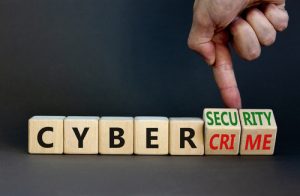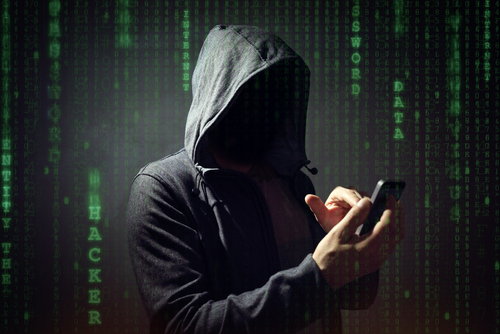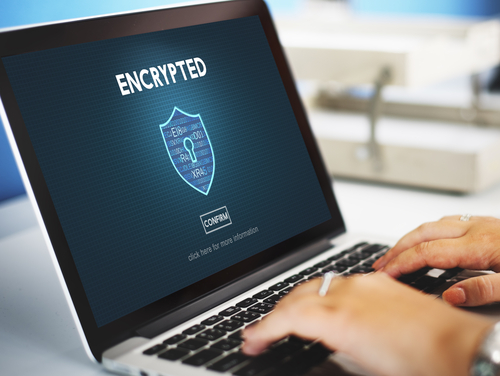Imagine logging into your bank account only to discover someone has emptied it completely or finding mysterious charges on your credit card statement from places you’ve never been. Scary stuff, right?
Well, welcome to the wired world we live in. Technology has transformed our lives for the better in so many ways, but it has also given cybercriminals new avenues to try and scam people out of their hard-earned money or sensitive information.
Luckily, with some basic knowledge of the most common types of cybercrime out there, which we’ll provide in this post, you can take the necessary steps to protect yourself and drastically reduce your risk of becoming a victim.

What Is Cybercrime?
In today’s technology-filled world, nearly everyone uses computers, smartphones, and the internet as part of their daily lives. Whether for school, work, entertainment, or keeping in touch with friends and family, digital devices and computer networks are now incredibly important.
However, as people and businesses do more and more activities online every day, cybercriminals have found new opportunities to cause harm through computer networks. Simply put, cybercrime refers to any illegal activities that involve a computer, smartphone, or other digital devices connected to the internet or networks.
Cybercriminals try to access people’s personal data, sensitive financial information, or confidential business/government records without permission. They might do this by tricking users into downloading malware or giving away passwords/account details.
The goal is often to steal identities and money or sell the stolen data to others.
Types of Cybercrime To Be Aware Of
With so many people living their lives online through social media, banking, shopping, and more, it’s no surprise cybercriminals have many ways to try tricking users. So, it’s important to understand the different tactics they use so you can recognize potential threats. Let’s look at some of the most common cyber crimes so you can spot the warning signs and stay safe.
Phishing Attacks
Phishing attacks try to trick people into giving away private information like passwords, credit card numbers, or Social Security numbers. Phishers do this through fraudulent emails or text messages that look real.
The emails might say they’re from a bank, online store, or other company you do business with. They’ll claim there’s a problem with your account and ask you to click a link to “update” things. But really, the link takes you to a fake website that steals anything you type in.
Sometimes, the messages say you just won a lottery or prize, but you need to verify your identity first before getting it. Again, the verification link is just a way for cybercriminals to access your data.
If you ever think a message could be phishing, don’t click suspicious links or open attachments. Instead, go directly to the company’s actual website through your web browser.
Malware and Ransomware Threats
Malware is a type of malicious software or malicious code that is designed to disrupt or gain unauthorized access to computer systems and networks. Viruses, worms, trojans, and spyware are all examples of malware. Cybercriminals often use malware to secretly install programs without the user’s permission, which can then do harm.
Some malware, like spyware, is meant to secretly watch what you do online through your webcams or track personal data for identity theft. Other malware tries infecting as many computers as possible to form “botnets” that hackers can control remotely. Meanwhile, ransomware is one of the fastest-growing malware attacks today.
Ransomware attacks work when cybercriminals encrypt important user files like photos, documents, and videos with complex encryption. This locks the files, so you can no longer access them. Then, a message appears demanding payment, often in cryptocurrency, to unlock the files again. If you fail to pay, you can lose the hostage files permanently.
Identity Theft
Have you ever worried about someone stealing your private information without permission? Well, identity theft is a real problem that happens when cybercriminals take personal details like your name, address, birth date, or Social Security number.
They might also get your credit card or bank account numbers. Thieves use many methods to gather this kind of information. Sometimes, hackers break into big companies through data breaches and access people’s records.
Other times, scammers trick victims into giving away their details during phishing scams. Sadly, identities are also stolen when personal mail is lost or thrown away without shredding. Once cybercriminals have your important details, they can pretend to be you.
Identity thieves may open new credit cards or bank accounts in your name. They might even get a phone or sign contracts for services like cable. This illegal use of someone’s identity for financial crimes without their consent is called identity theft.
Data Breaches
A data breach is when hackers access a large group of people’s private details without permission. Cybercriminals try breaking into big companies’ computer networks and servers where vital customer records are stored.
Sometimes, the criminals find weaknesses, called vulnerabilities, that let them get in. Or employees fall for phishing scams and accidentally help the bad guys sneak inside. Once in, hackers can copy and steal usernames, passwords, addresses, phone numbers, credit card numbers, and more personal data all at once from many people.
When these details end up in the wrong hands through no fault of the customers, it’s called a data breach.
Internet Fraud and Scams
Internet fraud and scams are two big problems we need to watch out for. Fraudsters make up all kinds of fake stories to steal personal details or cash. They might say you won a prize and need to pay taxes first. Or that a relative is hurt abroad and needs help wiring money.
Scammers also use romance scams, where they pretend to fall in love online and then ask for loans. They can also use fake lotteries, work-at-home jobs, and cryptocurrency schemes to try to get your money before disappearing.
These tricks spread fast through emails, texts, ads, and social media. So always confirm their credibility before sending money or files to people you don’t know.
Cyberbullying and Harassment
It’s quite unfortunate that cyberbullying and harassment are problems some people face on social media and messaging apps. Cyberbullies may send insulting, rude, or threatening emails, texts, posts, or direct messages to hurt or embarrass their victims.
Sometimes, bullies share private photos without permission, too. They also create fake accounts to impersonate someone or share private information to embarrass or humiliate the victim. Sometimes, they gather others to join in on the harassment, making it more distressing for the person being targeted.
Cyberbullying can have serious emotional and psychological effects on victims. It can lead to feelings of fear, sadness, or even depression.
Hacking
Hacking is when people break into computer systems or access things they’re not supposed to online. There are different types of hackers. Some just want to understand computers better, while others try to help companies by finding security weaknesses.
But, some hackers intentionally break the rules to steal data, spy on people, or cause trouble. Hackers might try guessing passwords to get into email or social media accounts. They may also search for vulnerabilities – like bugs or holes – in websites or apps to sneak inside networks without asking.
Once in, hackers can see or do anything within that system. This is why it’s important to protect your accounts with strong, unique passwords that are hard for hackers to figure out. Also, be wary of suspicious links since hackers sometimes use malware to hack devices.
Intellectual-Property Infringements
Copyright and trademarks are laws that protect creative works and brand names online. Copyright covers original writing, music, films, photos, and more. Trademarks identify brands so companies can sell their goods and services legally.
Patents also protect new inventions for some time. It takes hard work and talent to make these things. Intellectual property infringements happen when others use protected ideas, art, or products without permission. Some people illegally download or stream copyrighted movies, TV shows, and songs without paying for them.
Others make copies of books, games, or software to sell instead of buying the real versions. Downloading pirated content is stealing because artists and creators don’t get paid for their work.

How To Protect Yourself From These Common Cybercrimes
We’ve learned about some of the main cybercrimes, like hacking, identity theft, and scams, but it’s important to know how to stay safe online. The good news is there are steps we can all take to protect ourselves and our personal information from falling victim to these digital dangers. Read on for some easy tips.
Educate Yourself
One of the best defenses is staying informed so you know what threats exist. It’s easier to spot scams or hacker tricks when you educate yourself on cyber risks.
Learn the basics, like keeping personal info private and using strong, unique passwords for all accounts and devices. Understand how hackers try tricks like phishing scams so their emails look authentic. Know which websites to avoid downloading from.
The more you understand identity theft, malware, and online fraud, the less likely you’ll fall for criminal schemes.
Use Strong and Unique Passwords
Strong, unique passwords are tough for hackers to guess or crack. Instead of simple words or repeats of the same code everywhere, make passwords long phrases with a mix of uppercase and lowercase letters, numbers, and symbols.
This makes them much harder to figure out. Don’t use personal info like your name, birthday, or pet’s name. Hackers can search for you online and find clues. The longer and more random, the better. Also, avoid re-using the same password across multiple accounts.
This way, if one site gets hacked, others won’t be affected.
Enable Two-Factor Authentication (2FA)
Two-factor authentication, also called 2FA, is an extra step that verifies your identity even if hackers guess your passwords. After entering a password, 2FA sends a code to your phone or email that must also be entered to log in.
So, even if cybercriminals steal passwords somehow, they still can’t access accounts without that second piece of info. Turning on 2FA is simple. In your account settings, you’ll see an option to add your phone number or email for verification codes.
It only takes a few more seconds each time, providing much stronger protection.
Be Wary of Links and Attachments
When surfing online, always pause before clicking unfamiliar links or opening attachments. Hackers can use sneaky tricks to plant malware. Be very careful with emails or messages from people you don’t know well.
Scammers pretend to be companies, friends, or family but want you to click so malware installs. Even some ads or pop-ups contain malware links. Hover over links first to check the address looks real before tapping. Be wary of attachments, especially ones ending in .exe, as that’s how malware programs disguise themselves.
If a link seems suspicious or you weren’t expecting a certain attachment, it’s best to delete it untouched.
Use Caution on Public WiFi
If you’re surfing the internet at cafes, airports, or other places with free WiFi, extra care is needed. Public networks aren’t as secure as your private home internet. Open WiFi makes it easier for hackers nearby to see what you’re doing or intercept information sent from sites.
Always think twice before doing banking, shopping, or entering passwords at a coffee shop, library, or hotel that isn’t password protected. Avoid giving personal details if you must go online from a public hotspot. Disable auto-connecting to networks, and only use secure websites that start with “https://” instead of just “http://.”
Install Reliable Security Software
A final line of defense against online threats is using security programs. Computer viruses and malware are constantly evolving, so your protection must, too. Anti-virus software scans devices automatically for malicious software trying to install without permission.
It also looks out for suspicious activity that could indicate an infection. Some anti-virus options also include a firewall as extra armor. Firewalls monitor incoming and outgoing web traffic, blocking suspicious programs or hackers trying unauthorized access.
Keep Devices and Software Updated
Just like security programs need updating, so do the operating systems on all your devices. When companies like Apple, Google, and Microsoft release updates, it’s crucial to install them right away. These updates fix bugs and security flaws that hackers target.
They patch weaknesses that criminals could exploit to sneak malware or access your accounts. Many updates happen automatically in the background. But always check your phones, tablets, computers, and game systems periodically for manual updates.
Even apps and programs you use deserve regular security tweaks.
Back-Up Your Data Regularly
One way to protect your important files and photos is backing them up, so copies exist outside your main device. Backups act like a safety net if anything happens to your computer or storage. External hard drives or cloud storage services are great backup destinations.
Set aside time weekly to copy over new and changed files from your phone, tablet, or computer. You can even set automated options to do it in the background for you. Be sure to keep backups in a different location than the original in case of fire, flood, or theft, damaging multiple devices simultaneously.
The cloud is a handy off-site option since files are remotely stored versus locally.
Shred Sensitive Documents
While cybersecurity protects our devices, we must also safeguard physical papers with private details. Identity thieves can rummage through trash for discarded mail or files containing essential info.
When throwing away documents containing personal data like account numbers, medical records, or tax forms, simply tossing them in the regular trash isn’t enough. This exposes your information to being stolen and used fraudulently. Instead of risking identity theft, invest in a cross-cut paper shredder.
Run any papers containing sensitive financial, medical, or identifying details through the shredder before trashing.
Stay Cyber-Savvy and Keep the Bad Guys Out
We covered a lot about staying safe online from common cyber threats. The most important thing to remember is that being informed is your best defense. Now you know what kinds of cybercrimes exist, like hacking, identity theft, and scams.
But more than just knowing about the risks, you learned tangible steps to protect yourself.

